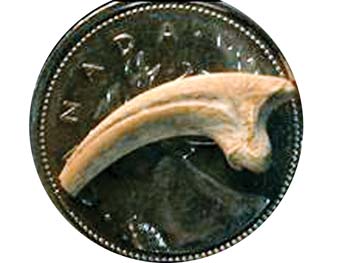
Smallest man-eating dinosaur discovered
The smallest meat-eating dinosaur yet to be found in North America
has been identified from six tiny pelvic bones. Hesperonychus was the
size of a small chicken, and used its rows of serrated teeth to feed on
insects, experts say.
The bird-like creature is closely related to Microraptor - a tiny
feathered dinosaur discovered in China. The specimen helps to confirm
that reptiles, and not mammals, filled the role of small predators
during the age of the dinosaurs. The fossil skeleton, which lay
misidentified for 25 years as a lizard, belongs to a group of dinosaurs
called the theropods - bipedal reptiles that eventually gave rise to
birds.
|

Bipedal reptiles like Hesperonychus eventually gave rise to
birds. |
“Despite the discovery of exquisitely preserved skeletons of small
bird-like dinosaurs in Asia, they are exceedingly rare in North
America,” explained Dr Philip Currie, a palaeotologist from the
University of Alberta and co-author on a paper on Hesperonychus.
Dr Currie had been pondering why so few small fossils have been
unearthed in Alberta, Canada - one of the world’s richest sites for
large-dinosaur bones. He suspected that small dinosaurs did not preserve
well in the region of the prevalence of larger predators in the area.
“There were many large dinosaurs running around eating them, and
small bones are easily washed away by rivers [common in this region
during the Cretaceous period]”, Dr Currie said. The new find casts more
doubt on whether mammals would have acted as small predators in
Cretaceous-era in North America.
The fossilised pelvis came from an animal that weighed no more than
1.9kg (4.2lb) and appears distinctively reptilian. “This tells us that
[as in Asia], North American dinosaurs likely out-competed mammals for
both large and small predator niches,” Dr Currie told BBC News.
The authors also suggest this discovery helps to resolve debate over
whether flight originated from animals that ran on the ground, flapping
their arms, or whether it started with tree-climbing animals gliding
downwards.
Based on the size of the hips, and because one of the hip bones was
bent - the pubis, a small bone that sits between the legs - “we know
this dinosaur was a tree-climber”, Dr Currie explained. “It likely used
the long feathers on its limbs to glide or parachute from tree to tree.”
The specimen, Hesperonychus elizabethae - named after its collector
Dr Elizabeth Nicholls - was reclassified by palaeontolgist Dr Nicholas
Longrich, a co-author of the paper, from the University of Calgary. The
findings were reported in a recent article in the journal Proceedings of
National Academy of Sciences.
-BBC News. |


